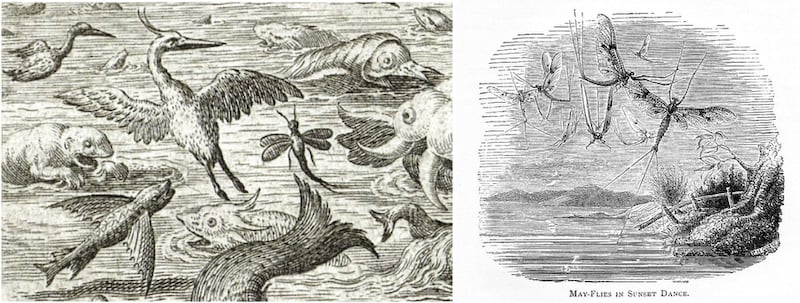Further afield: Mayflies in science, art and on your windshield by Steve Dietz
Last July we told you about the ecological importance of mayflies as both food source and bioindicator. Since they are such a phenomenon— thankfully so—throughout the summer, we thought we’d flesh out their story with more details.
Such as this one from the famed German artist Albrecht Durer’s 1495 print “The Holy Family with the Mayfly,” where he included a mayfly in the lower right-hand corner to indicate, presumably, the ephemeral nature of life and, some scholars suggest, a “cosmic resonance between sacred and profane, celestial and terrestrial, macrocosm and microcosm."
Think about that for a second or two.
 |
Albrecht Dürer, The Holy Family with the Mayfly,1495-/1496. Source: National Gallery of Art |
In art and literature, mayflies commonly represent life’s fleeting quality. Consider this description in the Epic of Gilgamesh, circa 2000 BCE: Ever the river has risen and brought us the flood, the mayfly floating on the water. On the face of the sun its countenance gazes, then all of a sudden nothing is there.
It is important to remember, however, that in the mayfly’s pre-adult, nymph stages, it can live for more than a year underwater. Their adolescence ends in a brief but spectacular adulthood. Their relatively long composite lifespan, however, makes them an important bioindicator, subject as they are to water quality over time and not just in passing.
Mayflies are perhaps not as well known as American Woodcocks for their aerial displays of courtship, but in fact they don’t just mate in the air—they perform an elaborate dance that might be described as up-and-down movement, like a winged horse moving steadily if jerkily skyward. When the mayfly stops beating its wings, it gently falls, its abdomen almost vertical.
Check it out some summer evening. So sexy.
It is important to remember, however, that in the mayfly’s pre-adult, nymph stages, it can live for more than a year underwater. Their adolescence ends in a brief but spectacular adulthood. Their relatively long composite lifespan, however, makes them an important bioindicator, subject as they are to water quality over time and not just in passing.
Mayflies are perhaps not as well known as American Woodcocks for their aerial displays of courtship, but in fact they don’t just mate in the air—they perform an elaborate dance that might be described as up-and-down movement, like a winged horse moving steadily if jerkily skyward. When the mayfly stops beating its wings, it gently falls, its abdomen almost vertical.
Check it out some summer evening. So sexy.
 |
| Left: Mayfly by Jan Sadeler after Maerten de Vos, detail from “The Fifth Day: The Creation of the Birds and Fishes,” 1587. Right: "May-Flies in Sunset Dance" by Philip Henry Gosse in a Victorian edition of Gilbert White's “Natural History of Selborne.” |
Mayflies often emerge in large numbers. That’s likely an evolutionary survival strategy, since any single mayfly is less likely to be eaten, statistically, when protected by the sheer numbers of the swarm, while at the same time, the hatch is an all-you-can-eat buffet for fish and birds. The hatch is often so large that it can be captured on radar by the NOAA weather station downriver in La Crosse, Wis., which has a web page for tracking mayflies.
Thanks Steve!
 |
| Mayfly emergence, NOAA radar Imagery (La Crosse, WI), June 1, 2023; 8:5 4-10:16 pm. |
Next time you are shoveling dead mayflies off your patio or cleaning your windshield, take a moment to appreciate that they have ancestral traits probably present in the first flying insects, a storied history in art and literature, indicate a healthy ecosystem, and can cut a pretty move on the dance sky.
Thanks Steve!
If you enjoyed this article, I highly recommend subscribing to the Frontenac State Park Association monthly newsletter edited by journalist and MN Master Naturalist volunteer Pamela Miller. It is full of lively nature articles, events at the park, poetry and photos that invite you to step out and learn about our natural world.
No comments:
Post a Comment